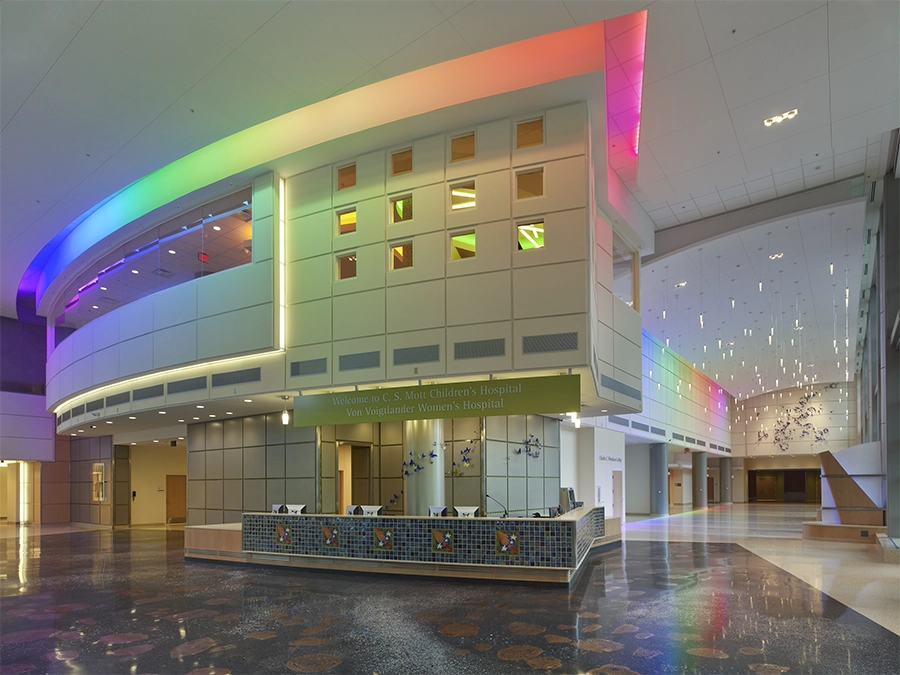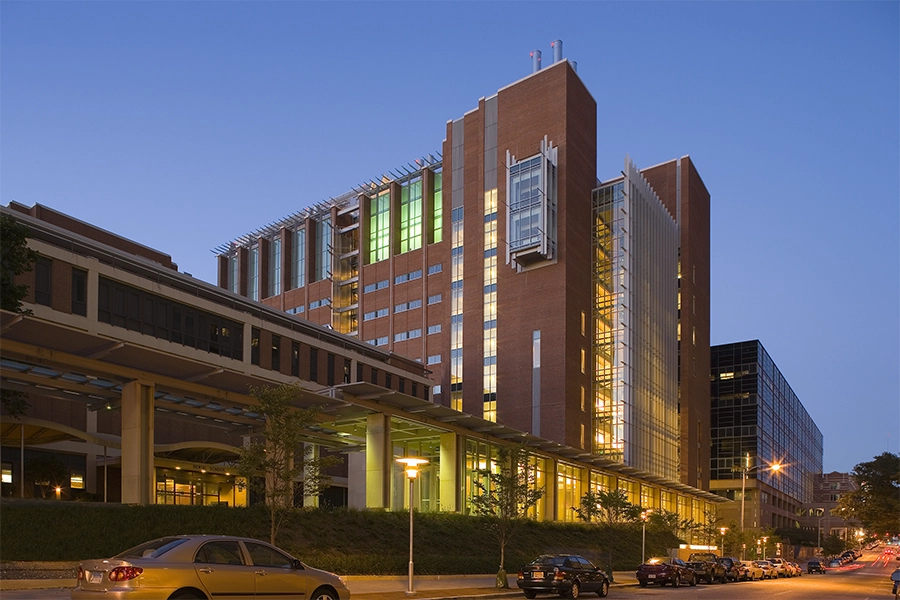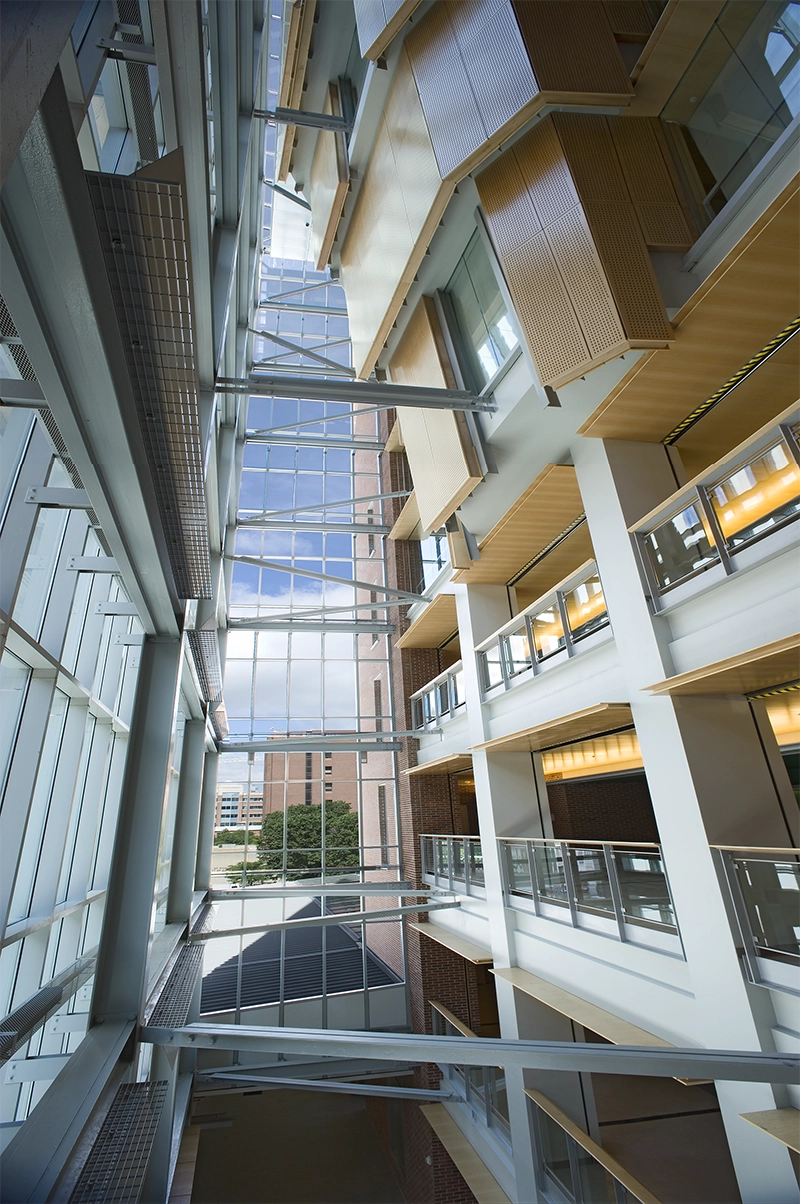Building Innovative Solutions: 2005-2010
Legacy of Leadership
This part of Barton Malow’s heritage story was written by Chief Community Officer Ben Maibach III in 2016. Ben III began his career at Barton Malow in 1964 and influenced the most significant growth period in Barton Malow’s 100 year history.
Globally, in this time frame, the economy reached soaring highs and deep lows. Having been in business since 1924, we know that such peaks and valleys are to be expected and that a long-range plan, coupled with the right tools, is necessary to weather such challenges while living and practicing our values.
Toward that end, Barton Malow has enhanced our use of Building Information Modeling (BIM), applied sustainable and Lean principles to more and more projects, continued to diversify geographically, expanded services to our clients, pursued more design-build work and invested in project management systems that simplify and promote the flow of project information. We continue to pursue leading-edge and innovative work that improves quality of life.
In 2005, for example, Barton Malow completed two projects that encourage resource conservation: the Alternative Energy Center for NextEnergy, which supports research, design, manufacturing and commercialization of alternative energy sources, and Automation Alley, a building with advanced IT systems that attracts the creators of diverse technologies from around the world.
Commitment to sustainability – our own commitment, and that of our clients – was reflected on several contracts. The Detroit School of Art, part of the massive Detroit Public School construction program, became the first LEED-certified building in the city; also, we installed a geothermal heating and cooling system at Whitmore Lake High School, which later won LEED Silver certification. We began work on Medlar Field at Lubrano Park, a shared minor league/collegiate facility, on the Pennsylvania State University campus. Later on, it became the first LEED-certified ballpark in the world.
In the meantime, to best meet client needs, we joint-ventured on several large, complex contracts. These included the 60-school, $820 million revitalization of the Toledo Public Schools, and partnering with Walbridge Aldinger (a long-time competitor) as construction manager on the new 26-gate North Terminal replacement at Detroit Metropolitan Airport.

Detroit Metropolitan Airport North Terminal - 2005
Barton Malow has long been among the top 10 nationally in K12 school building, and in 2005, that presence increased in the South. In the space of one year, we were at work on six individual contracts in Georgia and Florida, and that pace has accelerated over time.
In healthcare, another of our established markets, we were wrapping up construction at the University of Maryland Dental School, the first new dental school in the nation in more than 25 years. Providing all disciplines for teaching and research under one roof, it required close coordination among owner, architect, builder, subcontractors, and the City of Baltimore to keep work on track. Two massive new hospital campuses, Providence Park in Novi, Michigan, and Columbia St. Mary’s in Milwaukee commenced work.
Ben Maibach Jr. Retires
But for the Barton Malow community, 2005 was marked most significantly by a more personal milestone. In May of that year, my father, Chairman Emeritus Ben Maibach, Jr., retired after 67 years with the company. The company established the Ben Maibach, Jr. Leadership Award in his honor, which is given to one exemplary team member per year based on criteria that Ben Jr. modeled.
In 1938, he had “briefly” left Bay City, Michigan, to work for his father, employed as a carpenter foreman at Barton Malow — then a small Detroit-based general contractor. He hoped that within a few years, he’d save enough for a down payment on a farm. But unexpectedly, his career path was set into fast forward. Within a short time, his leadership potential was recognized, and he was promoted to a series of managerial and executive posts. Characteristically, he credited project success to his coworkers for their support and willingness to teach him. He became executive vice president in 1953, president in 1960, and chairman in 1976.
His influence is still felt through the presence of family members dedicated to the company, his occasional visits to headquarters and his desire to look after the long-term needs of company staff. Specifically, in 1952, Barton Malow became the first construction firm in the country to establish a profit-sharing/pension plan for employees; he was instrumental in making this happen.
In 2006, the retirement of Executive Vice President Mark Bahr brought additional changes. Similar to Ben Maibach, Jr. (who had planned on being a farmer), Mark had anticipated a career in cattle ranching. He committed five years to Barton Malow – and saw those five years turn into 32! Always, he measured his success by the extent his spiritual values infused relationships with family; friends, employees, clients and vendors, and he gained the greatest satisfaction from seeing the company prosper through ethical practices.
Moving Forward with BIM
A well-conceived succession plan by senior management allowed new leaders to be mentored and integrated into Barton Malow leadership, achieving a smooth transition. In 2006, Senior Vice President Les Snyder III was promoted to executive vice president, with responsibility for all Barton Malow Company operations, including regional offices, and in 2008, he was promoted again, this time to chief operating officer. A strong proponent of preconstruction excellence, Les co-authored The Contractors’ Guide to Building Information Modeling, published by the Associated General Contractors.
In fact, BIM is in widespread use on Barton Malow projects. It is commonly used to reduce field interferences during construction, but this software, at heart, is all about powerful data management, and that lent itself to many purposes.
For example, at the new Providence Park Hospital, 3D shop drawings were used directly for fabrication of steel and for above-ceiling utility mapping, for ease of maintenance in the finished building. The Centra Health/Lynchburg General Hospital team employed BIM to phase its new bed tower, promote communication among subcontractors and vendors and sequence trade labor. The University of Virginia South Lawn Project, an arts and science complex, required BIM to track and manage change orders. For the 1.1 million square foot Mott Women’s and Children’s Hospital, which broke ground in 2006, BIM was key to planning the site-safety program.

Mott Women's and Children's Hospital - 2011
Complementing BIM is Barton Malow’s re-dedication to Lean principles – management strategies that optimize workflow, staff involvement, quick decision-making, and the use of the best-available tools to minimize waste. It involves an interactive design-phase effort, including subcontractors, continuous value engineering, streamlining the submittal review and approval process, defining and communicating procedures to reduce rework, and employing advanced building technologies.
Continued Expansion
We have a corporate Lean team focused on enhancing value to Barton Malow clients while reducing operating costs both internally and on our project sites. Even simple, straightforward improvements, such as providing forms and manuals electronically and streamlining report procedures, have conserved time and budget.
In 2006, continuing our emphasis on geographic diversity, we opened a Chicago office. We had been building in Illinois and southern Wisconsin since the 1980s, and with a strong customer base, the time was right. As of this writing, in spring 2009, our principal local project is the University of Chicago Mansueto Research Pavilion at the Joseph Regenstein Library. It is a fascinating assignment, built underground with an elliptical glass dome at ground level. It features an automated storage and retrieval system (ASRS) to organize library holdings by size – not subject –increasing storage capacity sevenfold!

Joe and Rika Mansueto Library on the Chicago University Campus - 2011
Over the years, Virginia has been home to two Barton Malow offices and many projects. In 2008, we opened our third office in the Commonwealth, this one in Richmond and finished construction on the new visitors center at Monticello, home of Thomas Jefferson. It is an environmentally friendly building, set into a hillside, with a “green roof,” geothermal heat pumps for heating and cooling, and extensive use of local materials. The project opened to the public in April 2009, to coincide with Mr. Jefferson’s birthday.
Many other projects underscored our interest in environmentally sensitive building. Among such projects was the Stoney Corners Wind Farm in McBain, Michigan. There, the two wind turbines are the largest of their kind in the United States; assembly and erection, by Barton Malow Rigging, proved complex. With federal tax credits renewed in 2008, stimulus dollars available for renewable-energy projects and 25 states mandating (or considering mandates for) alternative-energy generation, the efficiencies practiced at Stoney Corners provide a relevant case study.
Out West in Phoenix, work was wrapping up on the Life Sciences Building at Paradise Valley Community College. Sustainable design practices are used throughout: Siting eliminated the need to truck in additional soil; the sloped roof collects rainwater, which is then used for irrigation; the corridors are completely shaded from the sun; materials include high-recycled content carpet and bamboo doors and millwork. The building itself is an important focus for environmental studies at PVCC.
Also in 2008, several long-planned initiatives were underway. Among them is a formal training curriculum for entry-level engineers, to help bridge the transition from university to workplace, integrate new employees into the project team and open a wide choice of assignments for each person. In addition, our Career Development Task Force accelerates staff development through effective job assignments while providing clients with the best possible team.
In 2008, the company committed to the second most expensive investment in company history – Project Keystone. This enterprise development system (ERP) closely links finance and project management systems corporate-wide. Project Keystone provides optimal integration, avoiding inefficient double entry and reconciliation. The automation allows finance and project personnel more time to devote to a higher level of customer service. Accurate and real-time project information, that is easily accessible, allows professionals at all levels of the company to make quick, effective, and well-informed decisions. This was a tremendous team effort, with close to 200 employees contributing time and expertise at various times in the development, testing, training and implementation process.
In addition, Barton Malow strengthened its presence in the federal market with the acquisition of L.C. Gaskins, Jacksonville, Florida. Now known as “Gaskins, a Barton Malow Company,” the firm has completed numerous federal projects over the past ten years, providing design-build, negotiated and general contracting services.
In 2009, our employees have achieved many milestones. These include the completion, at record speed, of the new Gwinnett Stadium in Georgia; the honor of having three other minor league baseball parks – NewBridge Bank Park, BB&T Coastal Field and Medlar Field at Lubrano Park – named best in their leagues by Baseball America magazine; our very first projects for Morgan State University and the College of William & Mary; and a Build America Award from the Associated General Contractors for the Erie (Pennsylvania) Bayfront Convention Center and Hotel Complex.
"The most positive note of all: In the spring of 2009, we reached a full year without a lost-time incident on any Barton Malow jobsite! Our customers, as well as our employees, recognize that safety excellence is a top priority and critical to project success."
In top-performing companies, safety never stands alone. Each employee concerned with safety, productivity, and quality allows us to grow and prosper. As we continue toward our second year of no lost-time cases, we cannot rest on this achievement. We continue to seek out the best ways to ensure the life and good health of everyone on a Barton Malow jobsite. Striving for excellence is a company driver and a longstanding Barton Malow hallmark.
During 2009 and 2010 the world economy suffered under a recession that dramatically reduced the amount of construction put in place around the globe. The total construction workforce has decreased and firms today are competing for a smaller piece of the pie. One thing good about a recession is that it begs the question of value.
Barton Malow turned its attention to innovation, believing that value is what you get for what you pay, which is measurably different than low price. We have made investments to elevate service, technology and to retain trustworthy, top-talent industry leaders with heart.
What we promise customers is value at every phase. We will continue to devote every day to building innovative solutions to earn customer loyalty.


